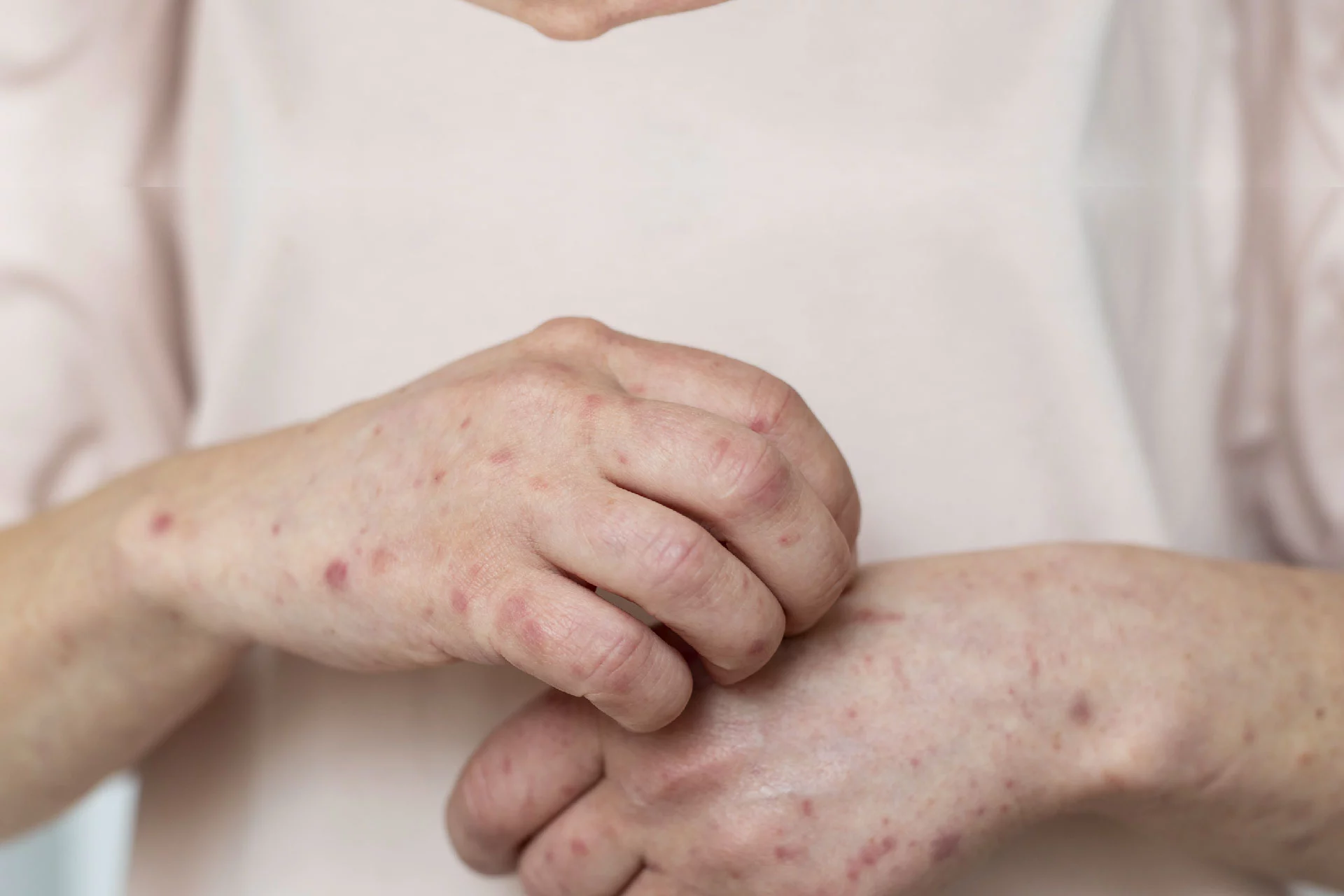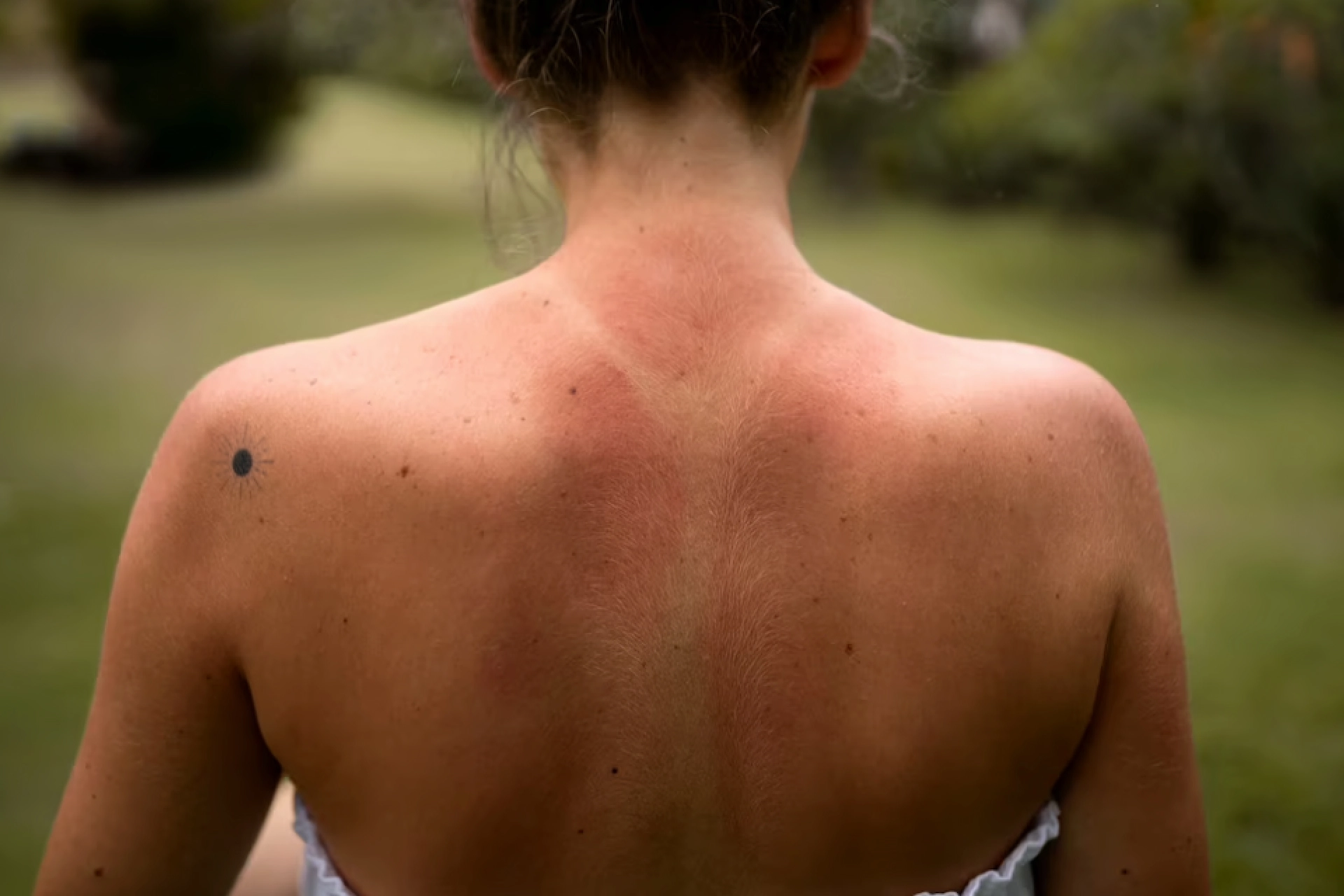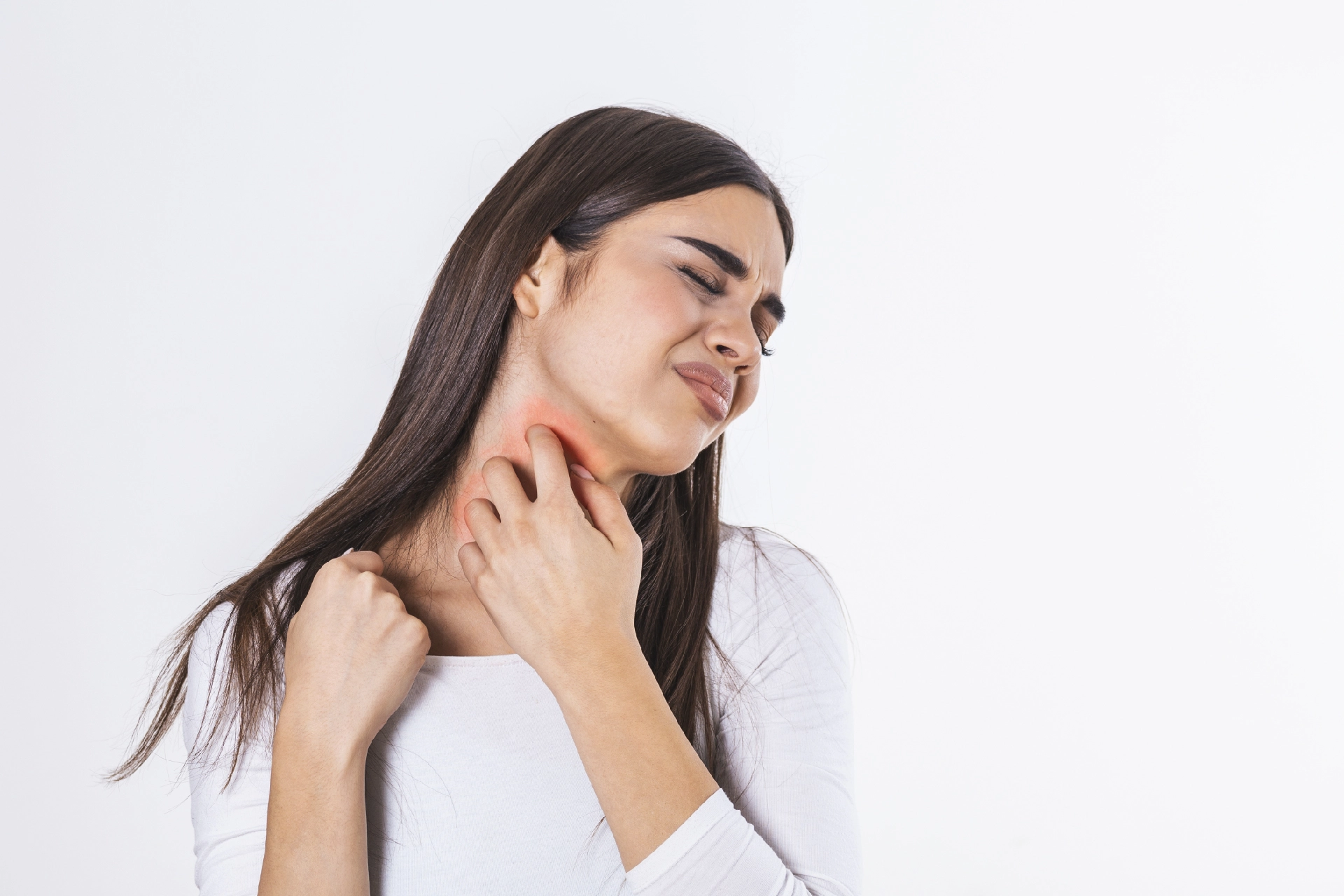Physical Medicine and Rehabilitation | 6 min read
Seborrhoeic Dermatitis: 6 Salient Aspects of This Condition
Medically reviewed by
Table of Content
Synopsis
Though seborrhoeic dermatitis has no adverse effects on your body, the condition can still irritate your skin. Know about the triggers, symptoms, and treatment options available.
Key Takeaways
- Seborrhoeic dermatitis doesn’t do any major damage to your body
- Common symptoms of seborrhoeic dermatitis include reddish and scaly skin
- Seborrhoeic dermatitis treatment options include prescription and OTC products
While seborrhoeic dermatitis is not severely alarming as it doesn’t cause any major damage to the body, it can still be irritating due to the constant itch that comes with it. For people suffering from seborrhoeic dermatitis, the scalp and skin on other body parts can become red, dry, and itchy [1]. However, it is of much relief that the condition is not contagious. You can get seborrhoeic dermatitis scalp treatment through skin care and medications. Read on to learn in detail about seborrhoeic dermatitis causes, symptoms, and available treatment options.
What is Seborrhoeic Dermatitis?
It is a common and noncommunicable form of dermatitis or eczema that can be managed easily. The condition primarily impacts the areas covered by the sebaceous (oil) gland, which includes the face, scalp, trunk, upper back, and chest, bends of arms and legs, back of the ears, belly button, and more. With seborrhoeic dermatitis, you get red, dry, scaly, and itchy flakes on your skin in these areas. For adults, the condition is commonly known as dandruff. For children, it is called a ‘cradle cap’. Note that despite treatment, this harmless condition keeps appearing occasionally.
Additional Read: Hives On SkinWho gets seborrhoeic dermatitis?
This condition impacts people across ages and ethnicities. However, there are some particular phases of life when it is likely to begin. For children, the condition is most common when a baby is aged between 2 to 12 months. It can also start appearing during adolescence. If you have moved past adolescence without this condition, there is a high chance of getting it after 30 years [2].
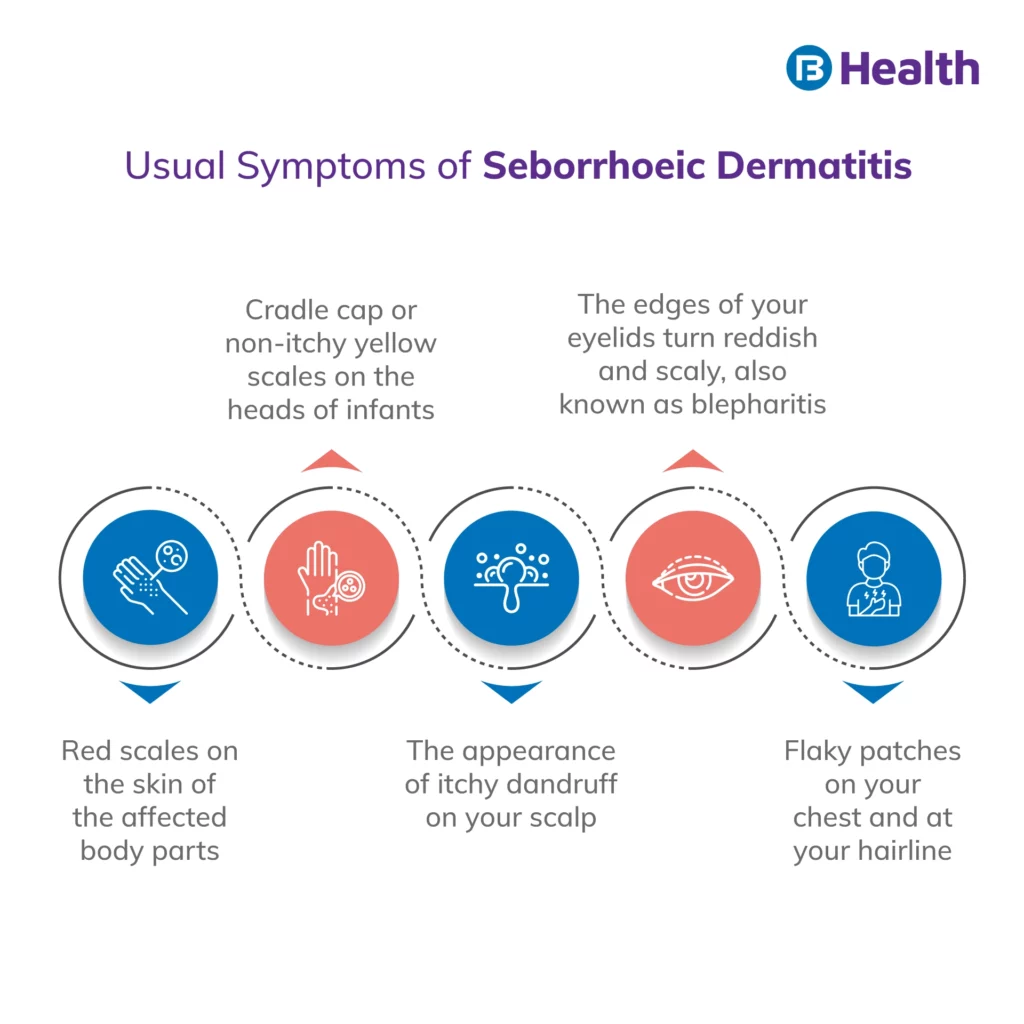
Seborrhoeic Dermatitis Causes
The usual causes of seborrhoeic dermatitis include several environmental and hereditary factors. In most cases, the condition gets triggered by an inflammatory reaction to pittosporum, commonly known as Malassezia yeast. When this organism living on the skin grows out of proportion, the immune system also becomes hyperactive, leading to a fungal infection on the skin.
Remember that conditions such as AIDS, rosacea, acne, Parkinson’s disease, epilepsy, psoriasis, depression, eating disorders, alcoholism, and more can spike people’s risk of getting seborrhoeic dermatitis. In addition, recovering from a stroke or heart attack can also put you at risk of getting it.
Here is a list of the frequent triggers of seborrheic dermatitis:
- Changes in hormones, especially a high level of androgens
- Recovery from the grief of losing a loved one or a major illness like a heart attack
- High level of skin lipids
- Alcohol-based lotions
- Oily skin
- Stress
- Season changes
- Cold, dry winds
- Medical conditions such as Parkinson’s disease and AIDS
- Medications such as lithium, interferon and psoralen
- Other types of skin disorders, such as acne, psoriasis and rosacea
Common Seborrhoeic Dermatitis Symptoms
It can be diagnosed in multiple ways. However, here are the usual symptoms:
Red scales on your skin:
They appear on the affected body parts
Itchy dandruff on your scalp:
The flakes of dandruff get uprooted on scratching, and they fall on your neck and shoulders
Cradle cap:
Appearance of non-itchy yellow scales on the heads of infants
Flaky patches:
With the shape of a flower petal, they appear on your chest and at your hairline
Blepharitis:
The edges of your eyelids become reddish and scaly
Apart from these, seborrhoeic dermatitis symptoms include redness and swelling around the armpits and genitals and beneath the breasts.
How to diagnose seborrhoeic dermatitis?
This type of eczema is relatively easy to diagnose as it is visible on your body and requires no test for confirmation. However, your doctor may recommend a skin biopsy to rule out any risk of malignancy.
Additional Read: Eczema Symptoms and PreventionsSeborrhoeic Dermatitis Treatment
Note that seborrhoeic dermatitis doesn’t go away without treatment. The course of treatment is usually decided as per the seriousness of the condition and the area affected by it. The treatment objective is to narrow down the visible signs of seborrhoeic dermatitis and its discomforts, such as redness and itching. You can go for both prescribed medications and over-the-counter (OTC) products. Prescribed medications for seborrhoeic dermatitis usually include corticosteroids, calcineurin inhibitors and topical antifungals. Apart from these, you may need continuous follow-up treatment. In most cases, you will need a combination of these treatments:
Treatment of scalp
For infants (cradle cap)
- It usually only requires treatment once a child is one year old. After that, you can treat this condition with a gentle baby shampoo
- Make sure to brush or massage the child's scalp multiple times daily using a soft brush. Take extra care while brushing the broken regions of the skin to avoid infections
- If these remedies don't help, contact your dermatologist or pediatricians. The doctor may recommend a prescription lotion or shampoo
- Affected skin areas other than the scalp can be healed with a soft steroid lotion
For young adults and adults
If it is a mild case of seborrhoeic dermatitis, over-the-counter dandruff shampoos containing coal tar, zinc pyrithione or selenium can help. It is best to apply them as directed by your doctor, as shown on the product's label. Your doctor may recommend a shampoo containing ketoconazole or ciclopirox for prolonged treatment. Make sure to use these shampoos as directed by the doctor until dandruff disappears completely. After that, keep applying it once a week or fortnight to prevent flare-ups.
In moderate to adverse cases of seborrhoeic dermatitis, your doctor may prescribe a shampoo with fluocinolone or fluocinolone solution, clobetasol or betamethasone valerate. In addition, shampoo your hair as per the doctor's recommendations. Also, ask the doctor whether you need to watch out for any side effects while using these shampoos.
Treatment of face and body
Common remedies for seborrhoeic dermatitis on your face and body include topical corticosteroids, calcineurin inhibitors or antifungals. Topical corticosteroids include hydrocortisone, fluocinolone, desonide or betamethasone valerate. You can get them as creams, foams, lotions, gels, oils, solutions or ointments. Topical calcineurin inhibitors are alternatives to corticosteroids. They include tacrolimus ointment or pimecrolimus cream. Common topical antifungals are sertaconazole, ketoconazole and ciclopirox. Take these medications as per the direction of your doctor to keep seborrhoeic dermatitis at bay.
Additional Read: How to Exfoliate Skin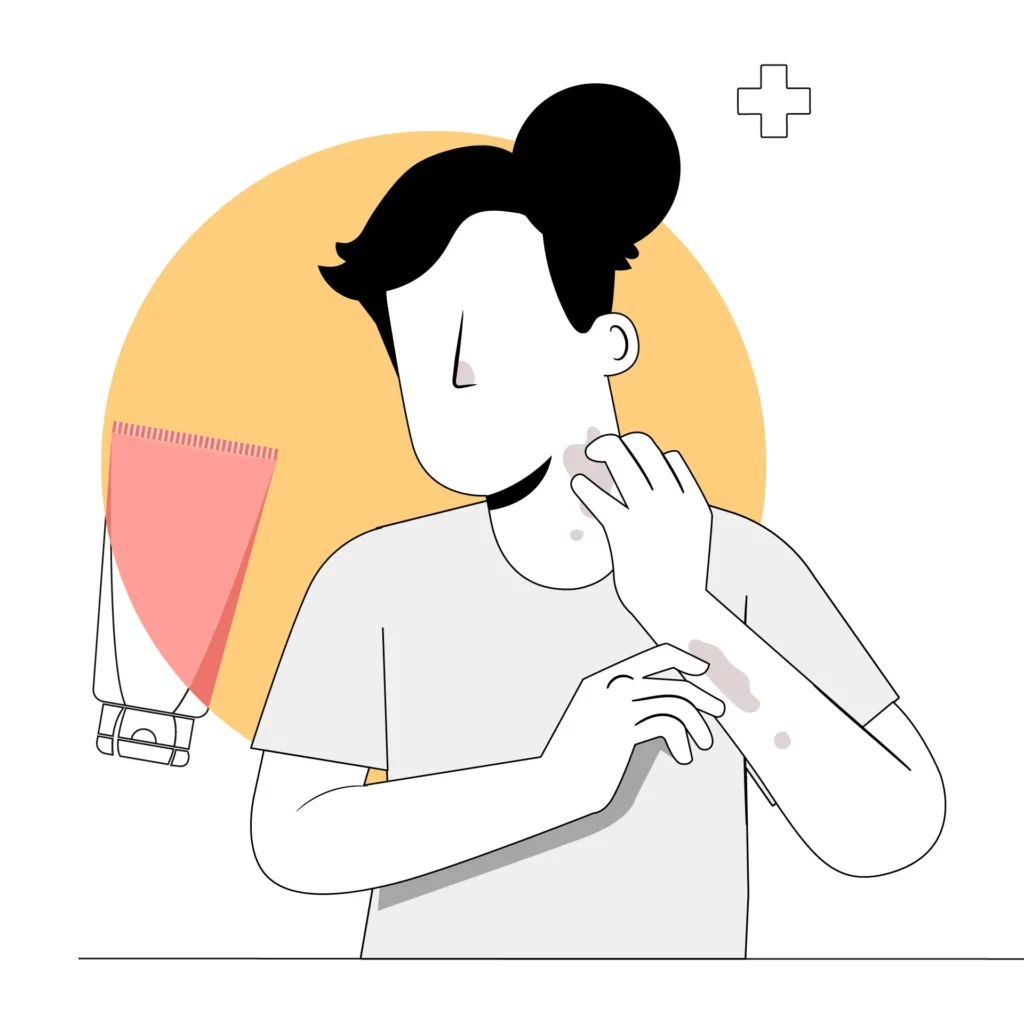
Complications of Seborrhoeic Dermatitis
Remember that neither cradle caps in children nor dandruff in adults have any major complication; you can easily manage them at home as they keep appearing throughout your life. However, if self-care doesn't help in seborrhoeic dermatitis, make sure to consult a doctor.
Conclusion
It is a type of eczema but different from hives on the skin. But all these disorders irritate your skin in some ways. You can get a doctor consultation on Bajaj Finserv Health to understand these conditions better and learn other relevant tips. By going for an online or offline consultation with a dermatologist registered on the platform, you can get all your skin health concerns clarified within a matter of minutes! Set up your health goals right away and make skincare an essential part of it for smooth sailing!
FAQs
Is seborrhoeic dermatitis related to acne?
Usually, seborrhoeic dermatitis and acne appear together as both are triggered by the oils present in your skin. If you have acne, you are highly likely to get dandruff.
Does seborrhoeic dermatitis cause hair fall?
No, it does not. It just makes your scalp and skin on other body parts red, dry and itchy.
References
- https://www.health.harvard.edu/a_to_z/seborrheic-dermatitis-a-to-z#:~:text=What%20Is%20It%3F,it%20is%20called%20cradle%20cap.
- https://www.aad.org/public/diseases/a-z/seborrheic-dermatitis-overview
Disclaimer
Please note that this article is solely meant for informational purposes and Bajaj Finserv Health Limited (“BFHL”) does not shoulder any responsibility of the views/advice/information expressed/given by the writer/reviewer/originator. This article should not be considered as a substitute for any medical advice, diagnosis or treatment. Always consult with your trusted physician/qualified healthcare professional to evaluate your medical condition. The above article has been reviewed by a qualified doctor and BFHL is not responsible for any damages for any information or services provided by any third party.
